So here they are, crowning this year’s 5:4 Best Albums list, the most imaginative, extraordinary and downright amazing releases of 2022.
15 | Nils Henrik Asheim – Salmenes Bok
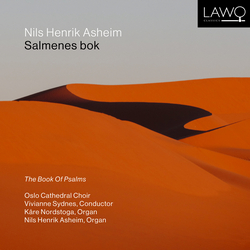
Nils Henrik Asheim’s Salmenes Bok is a cycle for choir & organ exploring passages from 21 of the Biblical psalms. These are so arranged to create an overall structure of five sections, each of which concludes with an ‘Alleluia’ for organ solo. Each section taps into the psalms’ considerable emotional contrasts and weight, though Asheim’s approach is very far from familiar word-painting. A good example is the single line exhortation taken from Psalm 27 (“Hide not your face from me”), rendered not with desperation or earnestness but a kind of broken distraction, the words emerging as barely audible but united syllables, one at a time.
The relationship between choir and organ is fluid. At times the instrument seems to act like the deity itself, an active presence by turns engaging with and disinterested in the voices as they seek to praise, lament and beseech. Elsewhere it takes on something of the details and actions in the texts, such as gruff clusters in Psalm 74, describing the power of god, or more overtly in the Alleluia movements where the organ evokes trumpets, tambourines, dancing and cymbals. As always with Asheim, the music is a masterclass in unconventional invention, bringing the psalms alive in an entirely new way, one that vividly reveals powerful, relatable emotional truths in their ancient words. [CD / DL]
14 | Beyoncé – Renaissance

“You know all these songs sound good”, Beyoncé remarks at the start of opening track ‘I’m That Girl’, and she’s not wrong. That’s putting it mildly; in a 20-year solo career where the hype has invariably tended to be more dazzling than the actual music, Renaissance is a long-awaited testimony to what Beyoncé is really capable of. The words take centre stage – except they don’t, not always: throughout, Beyoncé is accompanied by a shifting chorus of herself and others lurking on either side, on the fringes, in the distance. They respond, echo, interject, vocalise, acting not only to expand the lyrics but to ramp up the drama and momentum. This is an integral element in what’s perhaps the most outstanding aspect of Renaissance, Beyoncé’s relentlessly inventive wordplay and linguistic acrobatics (perhaps nowhere better than in ‘Church Girl’) – to the extent that, in some cases, this is so impressive in and of itself that engaging with the words’ actual meaning comes later.
But this would mean little if it wasn’t clothed in equally striking accompaniments, and through its series of mostly segueing tracks this veers from tender lyricism to blunt force swagger. The way seemingly incongruous elements enhance one another is especially impressive, as in album highlight ‘Thique’ where Beyoncé’s sensual delivery is beautifully matched with growling, buzzy electronics, or the stylistic volte face in ‘Pure/Honey’ (redolent of Of Montreal), shifting sideways into an apparently new song some time before its actual bifurcation. Structural fluidity of this kind is endemic to Renaissance, an absurdly irresistible song cycle dripping with bravado, sexuality, tenderness and cheek. [CD / Vinyl / DL]
13 | Get Well Soon – Amen

The year’s most sophisticated, emotionally arresting pop album comes from Konstantin Gropper’s ever reliable Get Well Soon. The band’s name has never been more apposite: Amen engages with the challenges, woes and despondencies of life, appropriately so for an album during the pandemic. That perhaps seems at odds with Gropper’s penchant for bright, effulgent pop, yet there’s absolutely no wallowing allowed here; as a (possibly artificial) voice declares at the start of the album, “This is an intervention”. Amen’s grappling with life starts from within in the humorous opener ‘A Song for Myself’, where Gropper’s dry litany of self-pity is met with a gloriously impatient refrain, “Stop your whining! Stop your bitching!”. It’s a tone of irreverence that seeks to burst any and all bubbles of despair, reinforced in the New Order-inflected floor stomper ‘My Home is My Heart’: “Just be yourself and love yourself, that should do the trick / Except when you’re a prick”.
The love may be tough, but it’s real. ‘I Love Humans’ is a somewhat anthropological tribute to humanity’s hope in spite of their failings – its neutrality broken up with big band stings – while album highlight ‘One For Your Workout’ (faintly evoking Kenny Loggins’ ‘Footloose’) directly challenges self-hate in a kind of modernised take on Samuel Beckett: “Relax, erring and failing’s fine / Just fail your best next time”. Often, Gropper’s delivery, despite the speed of the music, is slow and measured, bringing seriousness and solemnity to the songs, and making ‘Richard, Jeff and Elon’ feel like a valediction. ‘Us vs Evil’ lets out some pent-up anger – “I call BS” – but Amen’s conclusion is emphatically positive, suffusing its message with cheerful optimism. [CD / Vinyl / DL]
12 | Éliane Radigue – Occam XXV

Radigue’s latest Occam excursion takes the form of a 45-minute meditation for organ, performed by Frédéric Blondy. At a first (and maybe a second and third) listen, Occam XXV seems to be all about its pitch core, slowly setting up octave doublings and near-unisons to create sympathetic resonances and slightly discordant shimmerings. Yet what seems to be just as important are the ostensibly peripheral sounds: glimpses of high tracery like far-off birds; hard-to-identify noises that suggest distant thunder; even the accidental appearance of a passing ambulance outside Unity Chapel seems to contribute something valuable to the work’s glacial metamorphosis.
Nonetheless, it’s the central harmonic evolution that proves consistently hypnotic, new tones becoming folded into the homogeneous whole – or, at least, seeming to do so; perhaps we just accept them as part of the texture once they’ve appeared. Radigue harnesses the fundamental idea of tension and release, here rendered like music in freefall, continually teetering back and forth in a floating equilibrium, neither one nor the other yet always both. Especially exciting are periods of separation when the sense of a coherent whole is splintered, becoming clarified into a collection of pulsating strata. As with all Radigue’s music, what one hears in Occam XXV is a mix of actual sound and illusory effects, both of which change completely with each new listen. [CD / DL]
11 | Stefan Węgłowski – PHASE_1_4

“‘PHASE_01’ presents the key elements: a slightly pitched noise band, repetitions of a single piano note (C), and various forms of granular activity. Depending on your perspective, ‘PHASE_02’ is either a continuation of the preceding phase or a second attempt to create music from essentially the same elements, now reordered. The piano begins, soon surrounded by similar noise bands, but the granular material is here expanded, sounding both more corporeal (and more obviously electronic) and, more importantly, with a sense of implied power. […] A cycling pattern of pitches emerges later, rotating and reverberating until everything subsides into granular buzz and soft rumble.
… in ‘PHASE_03’ Węgłowski expands the identity and potential of the work’s elements, most obviously in the way the piano suddenly introduces additional pitches into its slender palette, now hammered out with real force. Energy is increased across the board: the noise becomes channelled into something akin to a wind tunnel, and the granular elements begin to swirl around the stereo field, emitting Geiger counter-like clicks. ‘PHASE_04_EPILOGUE’ offers nothing in the way of a conventional resolution. […] It hangs in space as if for eternity, implacable, unchanging – except for a surge in its bass register that persists for a few minutes – until Węgłowski slowly allows the cushion of air to expand just a little, but enough to slowly absorb everything else.” [reviewed in September]
10 | Saajtak – For the Makers

There’s a stylistic tension at the heart of Saajtak’s first full-length release. Though its ten songs display many of the tropes and trappings of rock, they play out within an altogether more imaginative approach to form, structure and narrative. Album opener ‘Big Exit’ is a case in point, essentially harmonically static while vocalist Alex Koi sings through various episodes that don’t exactly correspond to any conventional notion of a “verse”. The band progresses forward in a halting and jerking series of spasms that only feeds into the heightened emotional mood. This ostensibly incongruous melding of flow and anti-flow recurs in most of the songs. In ‘Concertmate 680’ it’s the other way round, Koi’s voice feeling her way forward while a burbling electronic undercurrent keeps momentum going, while in ‘Oak Heart’ (a duet with tenor David Magumba) the vocals float more freely over gently pulsing murmurations.
Another recurring trait is to subvert the already loosely-defined constructs established earlier on, tilting the songs into even more foreign territory. ‘There’s a Leak in the Shielding’ – featuring a beautifully pristine delivery by Koi, by turns hovering above us or intimately close, practically whispering into our ear – breaks down in its latter half to become a floating collection of pearls and dirt. Final track ‘Mightier Mountains Have Crumbled’ does this even more dramatically, breaking apart its radiant soundworld into something unfathomable. For the Makers is not rock, not even art rock, but music with sufficient ambition of outlook and execution that ‘rock’ ends up being a half-forgotten memory of a place of origin long since left far behind. [CD / Vinyl / DL]
9 | Francisco López – Untitled #400
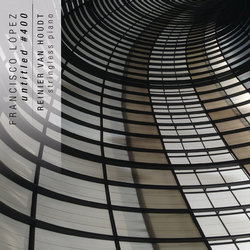
“The work comprises two movements, the first performed by [Reinier] van Houdt on the stringless piano, the second created by López as a “studio-evolved construction” using the sounds from the first movement. In movement 1, … there’s an interplay between regularity and some combination of irregularity, superimposition and convolution. […] The way this plays out … is fascinating, sounding as if van Houdt were caught in a struggle with the stringless piano, attempting to get the impacts organised again – or even, more intriguingly, as if it were all the product of a machine trying to restore metric sense to its chaotically glitching output.
The much longer … second movement develops the sounds and ideas from the first. Most obviously, the sonic palette is greatly expanded, the sounds of the piano processed so as to create new elements that evoke sustained pitch […]. This leads to an even greater ambiguity of texture, partly because the identity of certain elements isn’t always clear or apparent due to being heard in parallel with others while also undergoing evolution. […] Though capricious and unpredictable, there’s both logic and sense to the twin narratives heard in Untitled #400. As always with López, they’re narratives that are bound up entirely with the nature of the sounds themselves – what they want to do, where they want to go – but which are always coherent, and at their height, stunningly exciting.” [reviewed in November]
8 | Natasha Barrett – Heterotopia
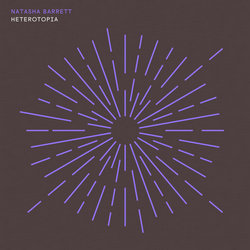
Heterotopia brings together three works of Barrett’s from the last three years, all of them demonstrating her unique gift for constructing intricate soundscapes where notions of real and unreal are both rendered moot. The most gentle of the three is Urban Melt in Park Palais Meran, a work bookended by glimpses of table tennis, between which we move through a series of discrete episodes that serve as windows into various parallel worlds. Here, ostensibly raw real world recordings intimately intermingle with heavily processed sounds, leading to a marvellously liminal kind of (in)tangibility. Growth, a piece created during the pandemic, is a short but potent study in sculpted reality, Barrett becoming like a scientist in a lab formulating new species of solids, liquids and gases. These are then brought together to create aspirated impacts, vaporous wind streams, intense collisions and smeared pitch bands. Somehow there’s even the impression of temperature, with certain sounds appearing to ‘burn’ through textures of crosswinds.
The title work is an amazing, 24-minute odyssey drawing on Foucault’s conception of places that are in some particular way ‘other’. Fittingly, the piece plays out like a field recording made within a dream. Often, it’s like wearing a parabolic microphone, with every tilt or turn of the head resulting in profound shifts in aural perception. The piece testifies to the superb intuitive approach Barrett takes to sound materials, where impossible transitions, unexpected drop- and fade-outs, and a constant evocation of tactile and abstract sound objects all become pseudo-‘natural’ elements within her uniquely immersive hyperreal phantasmagoria. [Vinyl / DL]
7 | Shiva Feshareki – Turning World
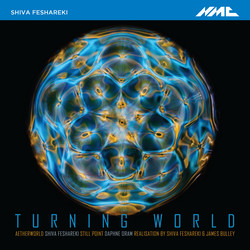
“One of the aspects that lifts [Aetherworld] from being just another meditative drone piece are the occasions when the voices become more demonstrative, unleashing a variety of sounds and whooping cries that project an entirely different kind of energy. […] The continual flux of emphasis between the intensity of the singers, the persistent weight of the organ and the electronic sounds penetrating through both makes it a genuinely other-worldly experience, and a fitting tribute to Josquin’s strikingly hypnotic music.
The main work on the disc is Still Point by electronic pioneer Daphne Oram. […] As a mid-20th century work combining a double orchestra … with turntables as a means to manipulate sound in real-time, Still Point is radically innovative. […] the post-Romantic noodling into which the orchestra periodically lapses becomes akin to a protrusion into a modern context of something from history, reinforced by the turntables’ surface noise coating the music with vinyl crackle. […] The two start to merge completely, the music’s Romanticisms sounding even more as if they’re memories resurfacing from a long-last past, given a lush gloss due to their at times filmic character. […] Flawed it may be in some respects, yet Daphne Oram’s Still Point nonetheless remains a staggeringly ingenious experiment in the integration of acoustic and electronic sound sources, and it’s entirely fitting that its greatly belated first performance should be preserved in this excellent recording.” [reviewed in November]
6 | Auteyn – Vigiles
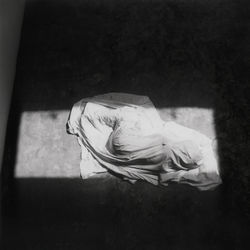
Auteyn is a new project from French composer / performer Benoît Lefèvre, attempting to find “unity in the diversity of his musical experiences”. The astonishing first product of that search is Vigiles, a five-movement work melding acoustic, vocal and electronic elements into a highly allusive, immersive soundworld. The introduction to this is ‘Conduit’, where a dark, heavily reverberant descending 3-note phrase – pregnant, noirish, possibly nightmarish – repeats like a foghorn on some black abyssal plane. Becoming more melodic, each gradual step forward is encrusted with grit and dust, touched by wisps of light, air and friction. This is extended in ‘Effraie’, where percussion strikes, scuffling noise, inscrutable rumble and various forms of hiss form the backdrop to something akin to an arcane act of spellcasting, filling the space with impossible, unfathomable, semi-imaginary shapes. They form a weird floating harmony, within which a dirty bass clarinet dances.
‘Vigiles’ introduces voices, finally providing a literal mouthpiece to the preceding, possibly preparatory actions. What they sing is impossible to make out but, interspersed with string passages, the tone is elevated, glowing with adoration, building to a shining climax. ‘Déserts’ switches attention to an organ, its steady, bright material accompanied by drones and other sympathetic pitch elements in a warm soup that undergoes a lovely rich swell, before dying back into mysterious scratching noise. The work’s conclusion, ‘Fanfare’, appears at first to be an act of simplicity, but its combination of harmonium and brass forms a rich tapestry of movement that, having appeared to end, looms massively, becoming like something ancient moving with majesty and gravitas, surrounded by a stunningly gorgeous corona of sheer coruscating ecstasy. [DL]
5 | Bekah Simms – Bestiaries

The three works featured on Canadian composer Bekah Simms’s second album find her both engaging with and beginning to move away from a clear use of existing musical materials. Foreverworld is an affectionate, somewhat abstract homage to metal music, reimagining and repurposing its attitude and tropes. It’s typified by an air of solemnity with an implied underlying aggression, articulating its energy in a lurching way that needs the backup of a bass drum to make real progress. The conclusion is an unexpectedly lovely blend of ethereal and atmospheric doomjazz.
Bestiary I & II utilises fragmented syllables and gestures from Joanna Newsom’s Ys as the catalyst for a bizarre menagerie. Populated by both real and imaginary creatures, singer Charlotte Mundy navigates her way forward with a never-ending avant-lyricality, while around her the environment continually shakes up and resettles, maintaining stability though with real intensity lurking below the surface. The highlight of the album is from Void, which takes its starting point from “an intentionally error-laden digital analysis” of Rebecca Saunders’ void. A work practically defined by its violent volatility, though disorienting and unsettling there’s always a sense of unity, articulated via a constantly shifting network of individual, sympathetic lines, behaviours and ideas. [CD / Vinyl / DL]
4 | LEYA – Eyeline

“… the tuning of Marilu Donovan’s harp is gloriously off-kilter, sounding not so much out of tune as tuned to an entirely individual system of notes that’s out of step with any known scale or mode. LEYA’s songs therefore occupy a realm outside conventional harmonic spaces. Sometimes tonality is strongly alluded to – opening track ‘DOG’, for example, is underpinned by a series of harp arpeggios that make the ear and the brain fizz at the almost-rightness of its triads – but often it’s simply an irrelevance, Donovan using the instrument as a vehicle for meandering exploration, glittering decoration or ponderous rumination. ‘Glass Jaw’ is arguably the most harmonically direct song, tilting between two chords while Markiewicz’s voice […] slowly progresses through a huge, shimmering halo of triadic light, his words seemingly causing optic ripples to radiate outwards.
[…] The fact that, in general, the range of elements is small and their behaviours are kept simple, plus the relatively short durations of each song (just a few minutes each) perhaps gives the superficial impression of Eyeline as a collection of rudimentary ideas or sketches. Yet they’re nothing of the kind, each one an intense, single-minded, fully-formed miniature act of expression that sits alongside the others like alternate approaches to urgently articulate the same thing, as unfathomable as it is overwhelming.” [reviewed in June]
3 | Congregation of Drones – Twenty Twenty

“An interesting aspect of Twenty Twenty is the relationship between Harris’ violin and Stiles’ electronics. The distinction between [them] is continually blurred and clarified, though it soon becomes clear that regarding the violin as soloistic, and / or the electronics as atmospheric, is a mistake. Both are both, or perhaps it’s truer to say both are neither: if anything characterises the duo’s relationship throughout Twenty Twenty it’s a consistent sense of sympathy and unity, where either component can come to the fore or retreat to the sidelines according to the organic whims of the music. […] That organic quality is what makes the album so engrossing and immersive. It’s the best kind of organic, not merely a music that ‘makes sense’ as it progresses but which allows for complete spontaneity – where, in spite of what’s gone before, we nonetheless have little to no idea what might happen next – yet where everything sounds just right.
The spontaneity and organic nature i’ve talked about combine to create an almost biologically-charged music, continually shifting shape, all the while retaining an ever more coherent and clearly-defined sonic palette. More importantly, though, is the simple fact that Twenty Twenty is absolutely stunning. The first thing i did after listening to it, was listen to it again, and then again. Barely a day has gone by since first contact when i haven’t revisited it to discover more of what’s going on in its amazingly intricate dronescapes, and every time the experience has been different, renewed; it’s as if the album didn’t definitively exist but were being reformed and recomposed on each new listen.” [reviewed in October]
2 | Rebecca Saunders – Skin
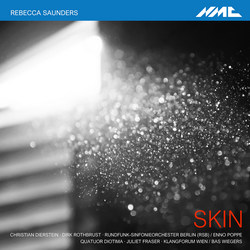
“Saunders’ music is typified by many things, one of the most obvious being struggle, effort, the determination to grapple, wrangle, articulate, and perhaps clarify. Fraser’s personification of Molly Bloom’s monologue [in Skin] is absolutely dazzling here, a locus of potential tangibility in the midst of a vast network of loosely but tangibly connected satellites. Surely one of Saunders’ most beautiful works, void is treated here to a low-key but hypnotic performance […]. i’ve noted before about the way the halting demeanour of the music becomes mysteriously continuous, and that’s again the case here, no doubt partly due to the behavioural similarities that permeate the primary ideas in the piece. All of which makes void‘s denouement all the more unsettlingly strange: first pitches become extended – a new element in this soundworld – then almost everything dissolves, leading to a hard-to-grasp final few minutes melding vestiges of that ghostly pulse with gorgeous, faint traces of shimmer. What’s been achieved? Are we anywhere different from where we began? Are such questions null and void?
Similar questions of negation and ‘anti-substance’ proliferate in Unbreathed, performed in this recording by the work’s dedicatees, Quatuor Diotima. […] In contrast to void, but similar to Skin, there’s a constant sense in Unbreathed that each and every action doesn’t just matter but is absolutely vital. The quartet contends around a single pitch, peppering it with swoops, slides, glistenings and tremolos, always – despite, again here, regular halting – giving the impression of a desperate tussling attempt. […]
Three baffling, brilliant, beautiful compositions by one of new music’s most fearlessly, effortlessly radical composers. Few albums can be described as essential, but this is absolutely one of them.” [reviewed in November]

1 | Bára Gísladóttir – VÍDDIR

There’s an experience unique to music festivals, that i’m sure i’ve remarked about in the past, whereby one feels an anxious mixture of disappointment, resignation and regret at not being able to attend every event, confident that one is definitely going to be missing the most outstanding concert of all. For the most part, i’ve been able to shake off that dubious belief over the years, but it’s come back with a vengeance the more time i’ve spent with Bára Gísladóttir’s VÍDDIR. It was performed at this year’s Dark Music Days in Iceland, and though i attended pretty much everything else, i wasn’t able to stick around during a mid-festival hiatus of a few days in order to catch this event. The fact that the performance was recorded and released does at least bring some comfort, but it’s abundantly clear that i missed not only the most remarkable music at the 2022 festival, but perhaps one of the most marvellous live performances i would ever have experienced. Disappointment, resignation, regret: check, check, check.
Putting all that aside, VÍDDIR is an astonishing musical creation. The more time i’ve spent with it, the more uncertain i’ve become about what exactly i’m listening to. Yet equally, the more time i’ve spent with it, the happier i’ve felt about that uncertainty. In my original in-depth exploration of the piece, i remarked about “a tilting between forms of vagueness and clarity, pressure and release, pitch and noise, though the tilting isn’t a simple oscillation but follows an altogether less predictable, more intuitive narrative.” It’s this fundamentally intuitive aspect of the piece which fuels the uncertainty, though even as i write those words they seem implausible due to the fact that VÍDDIR is a carefully structured, composed work – admittedly with lengthy periods of improvisation, yet intricately planned all the same. How it sounds so completely spontaneous is just one of many mysteries at the heart of the piece.
One of the characteristics of VÍDDIR that i like most of all is its willingness to bring together not just opposites but extreme opposites. The opening moments of the work give some indication of what’s to come, the choir of flutes articulating music that sounds like a hyperactive iteration of Jakob Ullmann, combining the solemnity of drone with intense buzzing and vibrating tones that soon transform into desperate screams. The outcome of this collision simultaneously evokes stillness, stability and timelessness as well as restlessness, volatility and a focus on the moment. At any point in the piece, the music is neither one nor the other but both at once, at times resulting in a profound sense of conflicted struggle, such as the close of the first section when the flutes move from a place of radiant beauty into uncomfortable wrangling. Gísladóttir extends this further in the timbral and behavioural palette she uses. Opulent elegance sits alongside earthy ugliness, the two usually interpenetrating each other; again, neither one nor the other, but both.
An area where my perception of VÍDDIR has changed – or, at least, developed – is in the relationship between the improvised sequences performed by Gísladóttir and Skúli Sverrisson on their respective (double and electric) basses, and everything else. It seems to me now that there’s another kind of opposite manifesting here, such that the bass improvisations are internalised, while the flute and percussion articulate a more externalised form of expression. This is partly a timbral consideration: the type of soundworld that Gísladóttir and Sverrisson create together is not merely immersive but almost hermetically-sealed. Listening to them together is like sitting inside a womb, enclosed on all sides in a warm environment subject to erratic swells and reposes, but where its fundamental character is familiar and predictable (even, in some respects, almost cyclical).
VÍDDIR thereby alternates its inscrutable act of expression between internal reflection and external declamation, each – depending on your perspective – potentially continuing where they left off when the other concludes (certainly, the way the flutes continue following the first improvisation section suggests picking up where they left off). Though the former are arguably more tangibly (if only allusively) connected to the worlds of melody and harmony, the latter offer greater openness and clarity due to the range of timbres if nothing else. This is reinforced by the fact that, whereas the bass improvisations bifurcate, Gísladóttir and Sverrisson at times semi-independently going their own way, the flute and percussion sequences are more behaviourally united, lending their music more transparency.
Yet while both the ‘external’ and ‘internal’ musics are often wildly, barely controllably dramatic, they’re nonetheless subject to another impressive aspect of VÍDDIR’s musical attitude, inasmuch as it isn’t always trying to grab our attention. This feeds into the work’s contemplative side, playing out – sometimes for minutes at a time – in a way that’s almost innocuous, seemingly oblivious to notions of ‘performance’ and ‘audience’. That only makes the work’s behaviour and purpose more elusive and intriguing.
Another kind of clarity that should be mentioned is that of the recording itself. The prospect of capturing this live performance must have been a daunting one, featuring spatialised performers in the large reverberant space of Reykjavík’s Hallgrímskirkja. VÍDDIR was conceived for precisely this kind of environment, though recording it in a way that makes clear sonic sense must have been one hell of a challenge. Yet not only is it a success, it manages to go a long way to recreating what it must have been like to have actually been there – and thereby reducing just a little of that lingering disappointment, resignation and regret.
Bára Gísladóttir’s compositional ideas thrive due to their continual blurring of concrete and abstract; we’re forever caught either between the two, or more often, in the midst of both of them simultaneously. VÍDDIR is not only an engrossing large-scale demonstration of this but, more significantly, a hugely bold and ambitious synthesis of her entire musical thinking, one that may prove to be a turning point, or the end of a chapter, time will tell. Whatever it is, or turns out to be, VÍDDIR is a unique, incredible experience, and without any doubt the best album of 2022. [DL]

Very strongly evoking Bowie’s Modern Love for me. Elsewhere, I sporadically detected a Pulp-meets-The-Divine-Comedy-meets-Arcade-Fire vibe – a not-unappealing combination. Thanks for flagging up!
[…] Gísladóttir. It’s impossible not to think of Bára’s earlier work VÍDDIR – my Best Album of 2022 – though where that piece was narratively complex and expansive, Ms. Ephemeris Abyss is […]